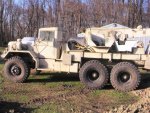It is a fact that singles Perform better off road, BUT Duels are by far the better set up for a cargo truck when loaded, now this is the same truck with the same weight and drive train, apples to apples...these tests were done before WW2 and again through out the early history of the US Army, simply put the single tire does not have to use up power and traction to widen the track made by the front tires.it is that simple...now as for the types and treads of said tires, all have a give and take, low air pressure is your all around BEST friend anywhere. NOW I will also say the driver is at least as important as the tire. wide tire sand, narrow tire mud and snow.are very basic rules, In the Mud in the Rains of Aberdeen past, the M37s Jeeps/Mutts and aired down deuce trucks out performed ALL other trucks that tried to pull others out, the Hummers did TERRIBLE with those wide tires in that very very SLIMY mud. Now the little Toyota or other type 2 wheel drive little light pickups with the cheapest narrowest tires cut right thru and left almost everybody in the dust, but they were not towning anything either,there are alot of factors out there ,but the basic rules as above are the best way to start out and learn from there, ..Randy...oh i just saw above the thought the NDT was crowned would sink? actually the NDT will air down to 15 PSI and be actually awesome and knurle overa and thru most as good as most other tires out there, now if one wants to try to run highway tire pressure , well that is when they get stuck, I call that driver error...Randy again...





